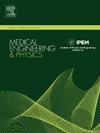Development of a peak insertion torque prediction model for parallel-walled dental implants
IF 1.7
4区 医学
Q3 ENGINEERING, BIOMEDICAL
引用次数: 0
Abstract
Implant peak insertion torque is a commonly used indication of primary stability that dentists rely on to make clinical decisions. The aim of this manuscript is to model the peak torque required for dental implant insertion based on clinical data such as bone properties, implant properties, and drilling procedure. A total of 116 parallel-walled Sweden and Martina dental implants were included in this study. Parameters such as age, sex, bone quality (derived from radiographs), applied peak insertion torque, implant location, implant length, final drill diameter, and implant diameter were recorded. Six data-driven regression models were trained and tested using different combinations of the clinical data to predict the peak torque. A physics-based model was also derived for the peak torque and compared with the data-driven models. The neural network model with early stopping achieved the best accuracy in predicting the clinically measured torque (R2 = 0.7692, MSE = 0.08815). Within the limitations of this study, the results suggest that it is possible to predict the peak torque required for implant placement based on the patient's radiographs, implant's properties, and drill diameter. The findings of this study can serve as a reference for dentists in choosing drilling parameters for dental implant surgeries.
平行壁种植体峰值插入力矩预测模型的建立
种植体峰值插入扭矩是牙医做出临床决策时常用的初级稳定性指标。本文的目的是根据临床数据,如骨特性、种植体特性和钻孔过程,建立牙种植体插入所需的峰值扭矩模型。本研究共纳入116个平行壁瑞典和玛蒂娜种植体。记录年龄、性别、骨质量(来自x线片)、应用峰值插入扭矩、种植体位置、种植体长度、最终钻孔直径和种植体直径等参数。使用临床数据的不同组合对6个数据驱动的回归模型进行训练和测试,以预测峰值扭矩。推导了基于物理的峰值扭矩模型,并与数据驱动模型进行了比较。早期停止的神经网络模型对临床测量扭矩的预测精度最高(R2 = 0.7692, MSE = 0.08815)。在本研究的局限性内,结果表明,根据患者的x线片、种植体的特性和钻孔直径,可以预测种植体放置所需的峰值扭矩。本研究结果可为牙医选择种植牙钻孔参数提供参考。
本文章由计算机程序翻译,如有差异,请以英文原文为准。
求助全文
约1分钟内获得全文
求助全文
来源期刊

Medical Engineering & Physics
工程技术-工程:生物医学
CiteScore
4.30
自引率
4.50%
发文量
172
审稿时长
3.0 months
期刊介绍:
Medical Engineering & Physics provides a forum for the publication of the latest developments in biomedical engineering, and reflects the essential multidisciplinary nature of the subject. The journal publishes in-depth critical reviews, scientific papers and technical notes. Our focus encompasses the application of the basic principles of physics and engineering to the development of medical devices and technology, with the ultimate aim of producing improvements in the quality of health care.Topics covered include biomechanics, biomaterials, mechanobiology, rehabilitation engineering, biomedical signal processing and medical device development. Medical Engineering & Physics aims to keep both engineers and clinicians abreast of the latest applications of technology to health care.
 求助内容:
求助内容: 应助结果提醒方式:
应助结果提醒方式:


